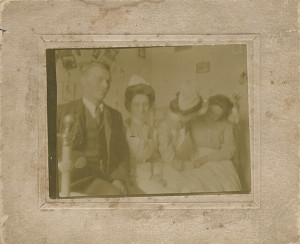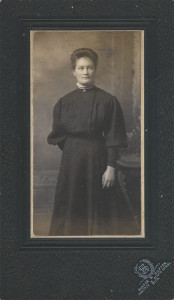A portrait of: Jackie Ryan Fagan (b.1890 Chicago, IL – d.1949 Coeur d’Alene, ID)
And: Thomas Christopher “Chris” Werner, (b.1927, Ferdinand, IN – d.2004, Indianapolis, IN)
Jackie Ryan Fagan was the grand nephew of Michael & Biddy Fagan. Jackie’s grandfather was Thomas Fagan, Michael Fagan’s younger brother (mentioned in the prelude A Letter Home). But Jackie’s story is a bit complicated and simply cannot be told without involving Katherine “Katchie” Werner (b.1897 – d.1944), and her son Thomas Christopher “Chris” Werner, (b.1927– d.2004). Chris was the great grandson of Michael & Biddy Fagan, and Jackie’s second cousin once removed.
Thomas Christopher Werner was born on February 15th, 1926, in the midst of the worst snowstorm in living memory in Ferdinand, Indiana. Chris’s mother, Katherine “Katchie” Werner (b.1897 – d.1944), was granddaughter to Michael & Biddy Fagan.

Dr. Axel Werner (b.1890 – d.1961) and staff taken 1914 Ferdinand, IN
Katchie was the youngest of nine children born to Patricia “Patsy” Fagan (b.1854 – d.1927) and Dr. Axel Werner (b.1856 – d.1929). Doc Werner was a physician and pharmacist trained in his native Germany. He came to the United States in 1879 and worked in the office of Dr. Martin Rohling, at No. 8 Lockport Street in Lemont, Illinois. The young Doc Werner met Patsy Fagan, a dour 29-year-old nearing spinsterhood during the course of several visits to the home of Michael & Biddy Fagan with whom Patsy still lived. Patsy’s mother, Biddy Fagan, was in declining health at this time and though under Dr. Werner’s care, died in her home in Lemont of pneumonia on November 22nd, 1881.

Patricia ‘Patsy’ Fagan (b.1854 – d.1927) taken 1882
Axel and Patsy were married the following spring and soon left for the University of Indiana in Bloomington when Axel was offered a teaching position at the medical school. In 1887 the couple relocated to Ferdinand, Indiana, a German-Swiss immigrant enclave in the southwest corner of the state. In addition to serving the local farming community, Dr. Werner was physician to the mostly German-born Benedictine Sisters located at the Abbey of the Immaculate Conception, perched high on a hill above the town. He also ministered to the monks at the nearby St. Meinrad Archabbey Monastery founded in 1854 by a Benedictine Order from Einsiedeln Abbey in Switzerland.
As Ferdinand’s only physician, Doc Werner’s practice flourished. In 1903, he engaged the services of the Keith Brothers Architects and built a massive Swiss chalet style home at 150 Main Street, on property that covered an entire square city block. On the southwest corner of the property he constructed a small building which eventually became the site of his son’s medical practice (Benjamin Werner b.1890 d.1961). The elder Dr. Werner established the town’s first drug store in the building in 1908 and it later housed the Ferdinand Post Office and a watch repair business — all operated by Dr. Werner.
Katchie worked in her father’s drug store from the day it opened; she was just 11-years old. As a teenager during WWI she volunteered for the Red Cross. She attended Indiana State Normal School (now Indiana State University) in Terre Haute from 1921-1925, earning a degree in nursing.

Maurice ‘Darky’ Fagan (b.1863 – d.1932) and Jackie Ryan Fagan taken 1891
In June of 1926 Katchie made her first and only trip to Chicago along with approximately one million other Roman Catholics from all around the world, to attend the 28th International Eucharistic Congress (the first such event held in the United States), hosted by the Archbishop of Chicago, George Cardinal Mundelein. Her mother arranged for her to stay with relatives she had never met – the family of her great uncle Maurice “Darky” Fagan (b.1863 – d. 1932) in Bridgeport, on the near south side and a short cable car ride from Soldier Field where the Congress festivities, Masses, and ceremonies were held. Darky Fagan was so called due to his thick and unruly head of jet-black hair, olive complexion, and brown eyes – inherited from his mother’s side of the family. He was also a fine musician and like his father Thomas Fagan, Darky played traditional Irish music on the fiddle in the style of Michael Coleman and other luminaries of the day. Darky played regularly as a member of the Ceili Band that was part of the Ireland exhibit on the Midway at Chicago’s World Columbian Exposition in 1893. His extraordinary musical talent landed him a job with the Chicago Police Department. He was recruited by a fellow traditional musician and police Sargent, Francis O’Neill, who in 1901 rose to the rank of Superintendent of the Chicago Police Force. Darky passed his love of Traditional Irish music on to all of his six children. However, the musical tastes of his oldest child, Jackie Ryan, took a far different path. Jackie gave up traditional Irish fiddle as a teenager, much to his father’s disappointment, when he first heard ragtime style and blues in vaudeville shows and emanating from the Negro juke joints that were beginning to pop up in the Bronzeville neighborhood east of all-Irish Bridgeport.

Jackie Ryan Fagan c.1947
When he saw a performance by the young “Guitar Wizard” Tampa Red (Hudson Whittaker), he laid down his fiddle for good and became hooked on the blues guitar. There was little acceptance for white musicians in the racially divided music that poured into the city during that time along with the Great Migration of African Americans from the rural south in search of jobs. Jackie wasn’t deterred and in 1924 he took to the road making his way to St. Louis, Memphis, New Orleans, and other bastions of the Blues, learning all that he could from anyone who cared to teach a white boy the Blues. In the years that followed his reputation as a blues guitarist grew, as did his penchant for women and shooting craps.
Jackie returned home briefly to Chicago – coincidentally while his cousin Katchie was visiting his father’s home in 1926. Jackie offered to escort her around the city. They spent their days together visiting museums and lakefront parks. In the evenings he took her around to the many Southside clubs to hear musicians he knew around town. It was no place for a respectable white woman. Katchie had worn out her welcome at the home of her uncle and hastily returned to Ferdinand, Indiana, where she took up residence with the Benedictine Sisters at the Abbey above the town ostensibly caring for those infirmed or in poor health, and tending to the endless daily household chores around the convent. In those days, it was the only safe refuge for a good Catholic girl from a prominent family to seek shelter if she suddenly found herself “in a family way.” A few years later she left the Abbey and moved with her toddler son into a small farmhouse owned by her father on the outskirts of French Lick, Indiana, 40 miles away.

Thomas Christopher ‘Chris’ Werner c.1941
She took at job at the New West Baden Springs Hotel. The hotel closed shortly after the stock market crash in 1929 and was purchased by the Jesuit Order who turned the massive hotel into a seminary. Katchie stayed on as a cook and housekeeper for the religious order until her death in 1944. She is buried in an unconsecrated corner of St. Julian’s churchyard cemetery west of town, on the edge of the Hoosier National Forest.
Jackie continued his life as a road musician, playing in pick-up bands whenever and wherever he could. In the fall of 1931 he came to French Lick for extended vaudeville engagements at the many resort hotels in the area – staying at the home of his cousin, Katchie. When he went back on the road in 1933 or 1934 he always maintained a correspondence with Katchie. Jackie quickly adapted his guitar playing style to the rise in popularity of hillbilly music and western swing and in 1939 wandered into Ciudad Acuña, Mexico, just across the river from Del Rio. He became a member of the house band on XERA radio performing with the likes of Jimmie Rodgers, Bob Wills, Roy Acuff, and the Carter Family. When the radio station folded in 1942, Jackie headed west to California.
Read More
1893 World’s Columbian Exposition
Abbey of the Immaculate Conception, Ferdinand, Indiana
St Meinrad Archabbbbey Monestary, St. Meinrad, Indiana
New West Baden Springs Hotel, French Lick, Indiana
28th International Eucharistic Congress

